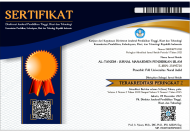Amhag, L., Hellström, L., & Stigmar, M. (2019). Teacher Educators’ Use of Digital Tools and Needs for Digital Competence in Higher Education. Journal of Digital Learning in Teacher Education, 35(4), 203–220. https://doi.org/10.1080/21532974.2019.1646169
Armfield, D. M. (2011). Multimodality: A Social Semiotic Approach to Contemporary Communication. Technical Communication Quarterly, 20(3), 347–349. https://doi.org/10.1080/10572252.2011.551502
Burnett, C., & Merchant, G. (2020). Literacy-as-event: Accounting for Relationality in Literacy Research. Discourse, 41(1), 45–56. https://doi.org/10.1080/01596306.2018.1460318
Correia, A. P., Liu, C., & Xu, F. (2020). Evaluating Videoconferencing Systems for The Quality of The Educational Experience. Distance Education, 41(4), 429–452. https://doi.org/10.1080/01587919.2020.1821607
Dicks, B., Flewitt, R., Lancaster, L., & Pahl, K. (2011). Multimodality and Ethnography: Working at The Intersection. Qualitative Research, 11(3), 227–237. https://doi.org/10.1177/1468794111400682
Doucet, A., Netolicky, D., Timmers, K., & Tuscano, F. J. (2020). Thinking about Pedagogy in an Unfolding Pandemic An Independent Report on Approaches to Distance Learning During COVID19 School Closures Independent Report written to inform the work of Education International and UNESCO. March.
Epps, A., Brown, M., Nijjar, B., & Hyland, L. (2021). Paradigms Lost and Gained: Stakeholder Experiences of Crisis Distance Learning During The Covid-19 Pandemic. Journal of Digital Learning in Teacher Education, 37(3), 167–182. https://doi.org/10.1080/21532974.2021.1929587
Halliday, M. A. K., & Matthiessen, C. M. I. M. (2013). Halliday’s Introduction to Functional Grammar: Fourth edition. In Halliday’s Introduction to Functional Grammar: https://doi.org/10.4324/9780203431269
Heritage, M., Jones, B., Tobiason, G., Chang, S., & Herman, J. (2015). Fundamentals of Learning. From the College and Career Ready Standards to Teaching and Learning in the Classroom: A Series of Resources for Teachers. Center on Standards and Assessments Implementation.
Hoffman, E. B. (2018). Untangling the Talk: A New Multimodal Discourse Analysis Method to Investigate Synchronous Online Learning. Journal of Digital Learning in Teacher Education, 34(3), 179–195. https://doi.org/10.1080/21532974.2018.1453895
Hol, D., & Aydın, I. (2020). Is Technology in Our Classrooms? EFL Teachers’ Beliefs and Engagement with Technology in The Classroom. Journal of Educational Issues, 6(2), 38-47. https://doi.org/10.5296/jei.v6i2.17326
Jewitt, C., Bezemer, J., & O’Halloran, K. (2016). Introducing multimodality. Introducing Multimodality, 37, 1–219.
Macgilchrist, F., Allert, H., & Bruch, A. (2020). Students and Society in The 2020s. Three Future ‘Histories’ of Education And Technology. Learning, Media and Technology, 45(1), 76–89.
Nave, R., Ackerman, R., & Judy Dori, Y. (2017). Medical Community of Inquiry: A Diagnostic Tool for Learning, Assessment, and Research. Interdisciplinary Journal of E-Skills and Lifelong Learning, 13, 001–017. https://doi.org/10.28945/3632
Pangrazio, L., & Sefton-Green, J. (2020). The Social Utility of ‘Data Literacy.’ Learning, Media and Technology, 45(2), 208–220. https://doi.org/10.1080/17439884.2020.1707223
Potter, J., & Cowan, K. (2020). Playground as Meaning-Making Space: Multimodal Making and Re-Making of Meaning in The (Virtual) Playground. Global Studies of Childhood, 10(3), 248–263. https://doi.org/10.1177/2043610620941527
Rapanta, C., Botturi, L., Goodyear, P., Guàrdia, L., & Koole, M. (2020). Online University Teaching During and After the Covid-19 Crisis: Refocusing Teacher Presence and Learning Activity. Postdigital Science and Education, 2(3), 923–945. https://doi.org/10.1007/s42438-020-00155-y
Selwyn, N. (2021). Ed-Tech Within Limits: Anticipating Educational Technology in Times of Environmental Crisis. E-Learning and Digital Media, 18(5), 496–510. https://doi.org/10.1177/20427530211022951
Siefert, B., Kelly, K., Yearta, L., & Oliveira, T. (2019). Teacher Perceptions and Use of Technology Across Content Areas with Linguistically Diverse Middle School Students. Journal of Digital Learning in Teacher Education, 35(2), 107–121. https://doi.org/10.1080/21532974.2019.1568327
Stenhouse, V. L., & Schafer, N. J. (2019). Empowering Teachers Through Digital Storytelling: A Multimedia Capstone Project. Journal of Digital Learning in Teacher Education, 35(1), 6–19. https://doi.org/10.1080/21532974.2018.1532359
Takala, M., & Wickman, K. (2019). Collaborative Case-Based Virtual Learning in Higher Education: Consultation Case in Special Education. Journal of Digital Learning in Teacher Education, 35(4), 236–248. https://doi.org/10.1080/21532974.2019.1646171
Teräs, M., Suoranta, J., Teräs, H., & Curcher, M. (2020). Post-Covid-19 Education and Education Technology ‘ Solutionism ’ : a Seller ’ s Market Content courtesy of Springer Nature , terms of use apply . Rights reserved . Content courtesy of Springer Nature , terms of use apply . Rights reserved . 863–878.
Vu, V., Warschauer, M., & Yim, S. (2019). Digital Storytelling: A District Initiative for Academic Literacy Improvement. Journal of Adolescent and Adult Literacy, 63(3), 257–267. https://doi.org/10.1002/jaal.962
Wisneski, J. E., Ozogul, G., & Bichelmeyer, B. A. (2017). Investigating The Impact of Learning Environments on Undergraduate Students’ Academic Performance in A Prerequisite and Post-Requisite Course Sequence. Internet and Higher Education, 32, 1–10. https://doi.org/10.1016/j.iheduc.2016.08.003

 (Universitas Islam Negeri Sunan Gunung Djati)
(Universitas Islam Negeri Sunan Gunung Djati) 







